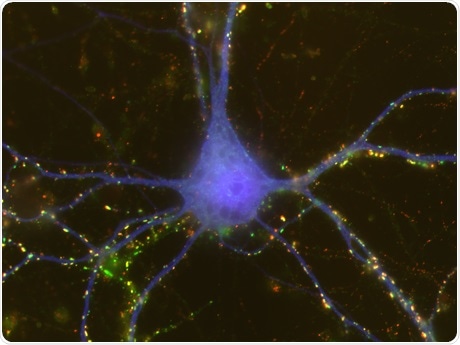Scientists from the Marshall University Joan C. Edwards School of Medicine have found that when brain cells develop, they may find various ways to link with each other based on sex.

A cortical neuron (blue) making numerous synaptic connections (red/green overlap) with neighboring cells after being exposed to astrocytic factors. Image Credit: W. Christopher Risher, PhD, Marshall University.
The study was published recently in eNeuro, an open-access journal from the Society of Neuroscience. It demonstrates a considerably more powerful synaptogenic response in male-derived cells than female-derived cells upon exposure to factors exuded from astrocytes—non-neuronal cells that occur throughout the central nervous system.
This difference was mainly caused by the way neurons responded to thrombospondin-2 (TSP2), a protein that exhibits cell adhesion properties and is generally secreted by astrocytes. During the study, TSP2 induced a strong increase in synapses in male neurons but showed no effect on female neurons.
This study offers compelling evidence that synapses, which act as the basic building blocks of brain connectivity, may be brought about by largely different mechanisms during early brain development.
“Our goal is to better understand at a basic cellular level if there are sex differences in how cellular networks form in the brain,” stated W. Christopher Risher, Ph.D., an assistant professor of biomedical sciences at the Joan C. Edwards School of Medicine and corresponding author on the study.
In this study, for the first time, we see evidence that events which were always assumed to be occurring in the same manner, regardless of sex, may actually be completely different in males compared to females. The fact that these differences involve astrocytes, which have traditionally been ignored in neuroscience but have recently become a hot topic for study, makes them all the more intriguing.”
W. Christopher Risher, Assistant Professor of Biomedical Sciences, Joan C. Edwards School of Medicine, Marshall University
For this study, led by first author Anna Mazur, Ph.D., Risher’s team isolated brain cells (astrocytes and neurons) from male and female newborn rats. The isolated cells were cultured for nearly two weeks in different combinations with each other and imaged on a fluorescent microscope to identify the number of synapses formed at the end of the experiment.
Moreover, TSP2 and several estrogen signaling regulators were used to treat the cells to determine the effect of each of the factors on the formation of synapses in male- and female-derived cultures.
The fact that we have identified molecular pathways present in males that are either absent or less prominent in females indicates that there may be much that researchers have missed in the area of synaptic development, simply because we weren’t looking separately at males and females.”
W. Christopher Risher, Assistant Professor of Biomedical Sciences, Joan C. Edwards School of Medicine, Marshall University
Risher and his colleagues continue to study the presence and effect of variations in cellular networks. Results from their study could eventually help open the door for sex-specific therapies for neurodevelopmental disorders, like autism spectrum disorder and schizophrenia, that present with strong sex biases in humans.
Source:
Journal reference:
Mazur, A., et al. (2021) Astrocyte-derived thrombospondin induces cortical synaptogenesis in a sex-specific manner. eNeuro. doi.org/10.1523/ENEURO.0014-21.2021.